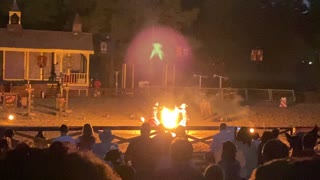Huge festival features show of devotion that few could endure
Kaavadi is one of the largest Hindu festivals in North America. More than 10,000 people gather each year to celebrate and share in a tradition that is steeped in history and mythology. Going back to ancient times, the legend speaks of a shrine halfway up a hill or mountain where people can journey to show their devotion and love for God. Offerings and displays of faith are a central part of this religious ceremony. Devotees seek blessings and renewal through worship and burden dance. The tradition has spread from India to Hindu communities worldwide.
Kaavadi (or Kavadi) itself means "physical burden" and is used to implore or ask God for assistance with healing, often for a loved one. It is often a time to renew spiritual balance through bearing a burden on a long pilgrimage route.
Devotees journey from far and wide each July to Val-Morin, Quebec, where they gather for this very important day.
But for some, it will be a test of will and physical limits that few people could endure. Many will have hooks pierced through the skin on their backs so that they can be led or pulled on the route as they carry decorated kavadi, or burdens. These kavadi may weigh as much as 30kg (66lbs). They will be decorated with flowers, peacock feathers, and other items, all significant and holding special meaning.
Undoubtedly, the most spectacular practice is performed by 6 men who have large hooks inserted through their skin, 4 on the back and 4 more on their legs. These hooks are attached to ropes and will be used to support the men as they are suspended in front of caravans for an incredible 8 hour pilgrimage from the temple around the local village. The caravans are led by the chariot which is used to pull a statue of Lord Subramanya as well as priests from the temple. Rows of devotees pull the chariot in front of the procession of dancers carrying their burdens and those suspended by hooks over the road in front of the caravans.
Ceremonial music is played, supporters offer prayers and blessings, and people walk alongside these men as they suffer through a grueling test of faith. They will not eat or drink anything except a few sips of water until they are removed from their hooks after an unbelievable 8 hours.
Beams and ropes are brought from Sri Lanka and India to create large booms from which the devotees are suspended. The wood is flexible and allows the men to be bounced up and down in time with the music. It is said that the concentration required to endure this feat of devotion is so great that the men will enter a trance like state and will not feel the pain.
Other traditions take place such as carrying milk or food on a devotee's head for the route. Some will have multiple piercings and others will have skewers inserted through their cheeks with decorative items being displayed. Throughout the pilgrimage around the village, no shoes are worn as a sign of worship and respect. For the men pulling the chariot, shirts are not worn.
When the chariot and the procession reaches the temple, the tradition of smashing 108 coconuts takes place. An offering to God and Lord Ganesha, this symbolizes renewal and smashing through obstacles. Coconuts hold special significance because they have three parts (hard shell, fleshy interior, and milky substance) which represent the physical body, the psychological entity, and the inner energy. A coconut is also smashed by each devotee at the temple to begin the pilgrimage.
Although this festival is a Hindu community event, they welcome anyone to attend and observe, or to join them and learn about their traditions and culture. There are two very obvious visitors in this video. Not only were they welcomed warmly at the temple and for the event, but they were given a saree and a dotee to wear throughout the ceremony. Invited to take part in the traditions, they were given an inside look at ancient customs and practices that few non Hindus have seen so close up. Such a rich cultural experience is an opportunity and an incredible display of generosity and acceptance from the Hindu community.
-
 1:14
1:14
WildCreatures
14 days ago $0.76 earnedSanctuary guest has dream close up encounter with sloth
4.08K5 -
 0:55
0:55
WEWS
3 years agoCleveland Humanties Festival features Northeast Ohio native as speaker
3 -
 1:47
1:47
KMGH
3 years agoTechnology that could stop a gunman
29 -
 0:50
0:50
Train Stuff
3 years agoLittle Steamer that Could
66 -
 0:26
0:26
Mr Producer Media
3 years agoMigrant: Biden Promised That We Could Cross Border
7576 -
 1:19
1:19
TheOriginal13
3 years ago $0.01 earnedLittle Peanut that could!
54 -
 1:19
1:19
jadanevans
3 years agoLittle integra that could ish
66 -
 0:36
0:36
Sdzbutler
3 years ago $0.03 earnedFire Show at The Texas Renaissance Festival
63 -
 1:15
1:15
AfricanNewsAgency
3 years agoNestle recall infant formula that could contain choking hazard
7 -
 0:54
0:54
Hempsolutionmiami
3 years agoStreetcode productions that ultra music Festival 2019
4